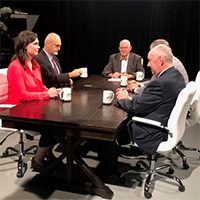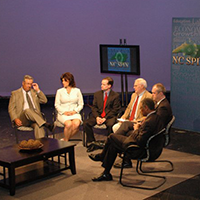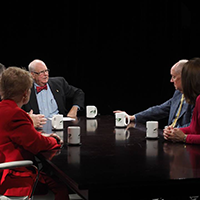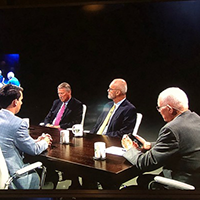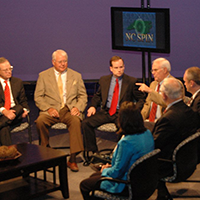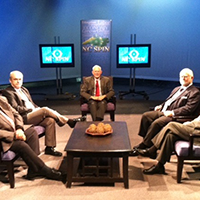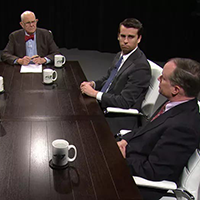Three North Carolina political scientists share their reflections on primary elections outcomes
Published May 19, 2022
With some sleep (and probably more caffeine than sleep), here are some reflections and thoughts following the 2022 mid-term primary. Each of us will provide our own thoughts, and if we repeat each other, well, that may mean it is something others should be paying attention to.
As a note: when the final voter data comes out after canvassing, we'll have a better set of empirical analyses to run, but here's what each of us are thinking following May 17's contest and preparations for the campaigns to November's general election.
By Susan Roberts:
As we know, partisanship is perhaps the single most important predictor in voting. That’s one reason primary elections are intriguing. These races don’t provide the voter with a clear partisan cue, and voters must rely on other factors to make their choices. Perhaps one of the best and most recent reflections on these was a piece by Elaine Karmack of the Brookings Institution on lessons from the March 2022 Texas primaries. Karmack argues primaries are “the most consequential elections in American politics,” adding they have long been regarded as “the ugly stepchild of American politics; ignored by journalists and snubbed by political scientists.” We aren’t going to ignore them here in the Old North State.
The four most noteworthy NC races for the U.S House of Representatives were NC-1, NC-4, NC-11, and NC-13. These races are my focus in several questions.
How do crowded primaries make a difference in the election outcomes?
The number of candidates in congressional primaries has steadily been increasing since 2010. Nationwide, there has an increase of more than 40% in primary contenders between 2010 and 2020, prompting Chris Raleigh of The Center for Election Science to note “there is no one guarding the House like they used to.”
Indeed, North Carolina's Thirteenth, perhaps the state's “swingiest” congressional district, boasted thirteen contenders, eight Republicans and five Democrats or as Laura Leslie of WRAL put it “13 Candidates for the 13.” Combining both Democrats and Republicans in the districts 1 (12 contenders), 4 (10 contenders), 11 (14), and 13 (13), there were 49 candidates across four congressional districts. Granted most of these candidates received a negligible number of votes, these individuals filed and ran based on some calculations beyond winning.
Would “dropping out” of a primary to throw your support to a top contender make a difference in a primary contest?
The short answer is not really, but given some highly contested primaries, it bears considering. The crowded field of candidates NC-11 lead to speculation that this fact alone might help incumbent Madison Cawthorn win the primary by meeting the 30% threshold. After all, Cawthorn advanced to and won a second primary in 2020 when no candidate received 30% of the vote.
What might have happened if the third-place finisher had thrown their support to the second-place challenger? In the NC First Democratic primary, Jason Spriggs’ 3% would have made absolutely no difference in helping Erica Smith’s 31% finish to Don Davis’ 63%. In NC-4, Clay Aiken’s 7% would have helped Nida Allam’s 37% but not enough to surpass Valerie Foushee’s 46%.
In NC-11 a shift to a two-person race would have boosted Chuck Edwards. Had the 9% of the vote Bruce O’Connell received been lopped on to Edwards 33%, it would have much more easily defeated Cawthorn’ s 32%.
Moreover, the results in NC-13 would have been enough to defeat Bo Hines’ 32% had Kelly Kathleen Doughtry’s 17% to Devan Barbour’s 23%. While there may have been some insider trading discussion, the concerted efforts to propel Edwards over Cawthorn had more to do with discrediting Cawthorn than working to promote Edwards through dealmaking with the other candidates.
Did any of these races tell us about the “establishment” factor in 2022?
What exactly do we mean by “the establishment?” While it may conjure up different things to different people and to different parties, the phrase means political actors be they office holders or interest groups less inclined to ani-government rhetoric, less inclined to wholesale campaign finance reform, and less more inclined to internal factionalism. Whether measures by monies or endorsements, the establishment played to varying degrees in all four primaries.
The influence and involvement of “the establishment” was most clearly seen in the NC-4 Democratic primary and the NC-11 Republican primary.
NC-4 was an open seat following the retirement of longtime Representative David Price. The primary race was considered by Asher Hildebrand, former Chief of Staff to retiring David Price, to be “a kind of microcosm of debates over the future of the Democratic Party.” The three leading candidates could not have been more different. Nida Allam, a 26-year-old serving as a member of Durham County Board of Commissioners and the first Muslim woman elected to political office in North Carolina ran a progressive campaign based on her vision for the future. She received endorsements from Bernie Sanders, Alexandria Ocasio-Cortez and Elizabeth Warren, as well from the Progressive Caucus of NC Democratic Party after withdrawing the group's support for Allam's top competitor, Valerie Foushee, when Foushee received support from the American Israel Public Affairs Committee (AIPAC) .
Foushee did indeed receive well over $800,000 from bundling monies from AIPAC, as well she received substantial support from a PAC called Protect Our Future and funded by a Bitcoin entrepreneur. In addition to the controversial PAC monies, Foushee received endorsements from Emily’s List, the leading and oldest PAC dedicated to electing pro-choice Democratic women, and Higher Heights, a PAC solely working to fund and elect Black women to public office at federal, state and mayoral levels. Along with these special interest group endorsements, Foushee received endorsements from Jim Clyburn, Josh Stein, G.K Butterfield, and Alma Adams.
Perhaps no other primary race received more national attention that the Republican primary for NC-11, thanks to the rhetoric and unseemly, to put it most charitably, misbehavior of the incumbent, Madison Cawthorn. Most noteworthy was the U.S. Senator Thom Tillis aligned PAC, Results for NC, a group driven to defeat Cawthorn. Their video, titled Madison Lies, painting a damning portrait of a deceitful opportunist who is more interested in celebrity than constituent service and the values of the Republican party. representing NC values.
As Cawthorn’s actions became increasingly outlandish rhetoric and more disturbing photos and videos emerged, Republican officeholders became increasingly more adamant in removing him from office. House Minority Leader Kevin McCarthy became increasingly intolerant of Cawthorn and his impact on the Republican party. Only Donald Trump endorsed Cawthorn unequivocally and forgave his misdeeds.
Other establishment groups aided candidates in NC-1 and NC-13. Retiring Representative G.K. Butterfield endorsed Don Davis over Erica Smith, helping Davis to a big win on election night. The conservative wealthy PAC, Club for Growth, endorsed Bo Hines over other Republican candidates.
Endorsements and outside monies are not unique to these races, but in crowded primaries, they can provide some cues as to the direction of the parties. These primaries are all the more significant in evaluating the impact of Donald Trump on the Republican party.
By Chris Cooper:
The last 24 hours has been a heck of a week, but I think I’ve cleared through the mental cobwebs enough to form some early take-aways.
Statewide Take-aways
Turnout is a glass half full. 19.6% of registered voters in North Carolina turned out in this primary—just a hair shy of the recent midterm primary high-water mark in 2002. On second thought, maybe that glass is half-empty. Fewer than 1 in every 5 registered voters in NC cast a vote in this primary, despite the fact that there were important races from the top to the bottom of the ballot. I’m an optimistic fellow, so I’ll take the original lesson, but feel free to lean into the glass half empty perspective if you prefer. After all, they're both true.
The way we vote is changing. 60% of votes were cast on election day in 2022—the smallest proportion of election day votes in a NC midterm election in recent history (and likely ever). In addition, mail voting (although still a relatively small proportion) showed a large increase. I expect that voters will continue to slowly drift away from election day voting in the years to come.
Unaffiliated voters can (and do) make a difference: The fact that Unaffiliated voters can choose their own adventure on primary election day combined with the increasing number of Unaffiliated voters in the state has introduced even more volatility to an already volatile primary electorate.
Ballot order matters: It is well-established that candidates who are listed at the top of the ballot receive a larger vote share, all else being equal, than candidates who are lower on the ballot. North Carolina addresses the ballot order problem by randomly assigning the order of names. In 2022, candidates whose name begins with "C" were listed first on the ballot, followed by candidates whose names begin with "D" then "E" and so on.
In most elections, it didn't make a difference. In some, it could matter. Consider the Deanna Ballard v. Ralph Hise election. Hise and Ballard are both incumbents who were paired in a new district where each shared about the same number of voters from their old district. Hise's name came first on the ballot and he won by less than one percentage point--easily within the potential effect size of the ballot ordering effect.
NC-11 Take-Aways
Thomas Wolfe was right, you can’t go home again. Of all Madison Cawthorn’s unforced errors, the one that likely had the biggest impact was when Cawthorn left the district and came back. When he left the district, the Republican field consisted of Wendy Nevarez and Rod Honeycutt. When he came back, Chuck Edwards, Matthew Burril, Michele Woodhouse, and Bruce O’Connell had been added to the mix (Kristie Sluder came later). If Cawthorn had never "Gone Charlotte,” it's unlikely that Chuck Edwards would have entered the race. And Madison Cawthorn would likely be on his way to the General Election.
Rules Matter. If North Carolina didn’t have a runoff rule, Cawthorn wouldn’t have been elected in the first place and we’d be discussing Congresswoman Bennett’s re-election potential. If the NC General Assembly hadn’t voted to move the threshold down to 30% in 2017, we would be currently talking about the forthcoming runoff.
Representation Matters. Edwards only won three counties in the race for NC-11: Transylvania, Henderson and Buncombe. Those are the very same counties he represents in the NC Senate. Playing to the home team was his strategy, and it worked.
Cawthorn ran a national campaign for a district office. He didn’t do ad buys on WLOS and other local outlets. He closed district offices during the campaign and he didn’t show up for debates late in the campaign season. The messaging he sent to voters was about fundraising, not votes. While money is helpful when you want to buy taxidermy for a door prize, you need votes to win an election.
Edwards was buoyed by high turnout and Unaffiliated voters. More than 88,000 people voted in the Republican primary—that’s 97% of 2020 Republican turnout. We don’t have the election day data back yet, but in early voting Unaffiliated voters made up 42% of the Republican electorate in NC 11. That’s a big number. And a number that mattered.
Don't tick off Thom Tillis. We’re used to politicians attacking members of the opposing party. Sometimes in primaries, things get nasty between members of the same party. But it’s extremely rare for an elected official to attack members of their own party who they’re not running against. And it’s even rarer when they’re from the same state. But that’s what Madison Cawthorn did—he did it with Tim Moore. And he did it with Thom Tillis.
Eventually, Tillis decided he had had enough. And when Tillis decides he's had enough, he responds by dropping a few hundred thousand dollars against the person attacking him. And that money wasn’t spent on taxidermy or dinners at Papas and Beer, but rather on mailers, ads, and direct outreach to voters to defeat Madison Cawthorn. And it worked.
By Michael Bitzer:
The non-surprise of Tuesday's primary:
First, of course, the marque contest proved to be an even bigger landslide: the Republican nomination fight for the U.S. Senate wasn't so much a fight as a coronation.
Expectations were that U.S. Representative Ted Budd would have the nomination, it was just how big would his victory be and could former N.C. Governor Pat McCrory keep it close. In the end, a 58/24 Budd/McCrory split seems to signify the GOP electorate is solidly a Trump Republican electorate. Combine Budd's 58 percent with Mark Walker's slightly under ten percent performance, and over two-thirds of the GOP electorate backed Trump-style Republicans, especially one with the coveted endorsement by the former president.
With two-thirds of the electorate going for obvious Trump Republicans, Pat McCrory's quarter of the vote signals that the Reagan-conservative Republican wing of NC's GOP is now in substantial minority status. As McCrory lamented after the election, where do these Republicans now call home? The tension has been for some time as to the dominant faction within the GOP, and it's no doubt now that Trump Republicanism is the core of NC's Republican Party. While McCrory's kind of Republicans may keep their party identity, the question is: will they have the same enthusiasm and energy when it comes to general election turnout for Trump Republican candidates? Only time will tell.
Tuesday's primary surprise:
As my colleagues above have noted, the only real surprise of the night was the Republican primary in NC's 11th Congressional District. I'll defer to the expert analysis of my colleague Chris Cooper, but some general thoughts on the tenure and fall of U.S. Representative Madison Cawthorn.
Much has been written, from trying to humanly understand Cawthorn's time in office to others gleefully extolling his foibles. My honest gut reaction centers on the myriad of issues confronting Cawthorn that, when combined, doomed his bid, if only by one-and-a-half percent:
* Cawthorn’s political adolescence, launching incendiary rhetorical bombs rather than looking out for his broader constituents.
* His hubris in thinking he could abandon the mountain district to go after the speaker of the NC House and anoint himself kingmaker within the state’s GOP party politics by endorsing Bo Hines and Sandy Smith.
* His political self-interest when that map didn’t play out and running back home without even a sense of remorse.
* His lack of basic congressional professionalism, in terms of constituency services and aid to the voters back home, something that should be an invaluable resource to building a re-election bid in the vulnerability of a first-term member.
* His self-inflected political wounds that alienated him from his national colleagues; and speaking of alienating your party friends,
* His facing the wrath of the NC Republican establishment, coordinated by a sitting U.S. Senator, who threw everything they had against a vulnerable first-term incumbent.
That Cawthorn garnered a second place finish with 30 percent demonstrates that even with all of the above at issue, a strong core of mountain Republicans supported him. His demise in Henderson County, combined with the overlay of Chuck Edwards' state district from that same county, made it clear that Cawthorn's "friends and neighbors" were done with the antics: within Cawthorn's own precinct (Rugby) of Henderson County, only 27 percent of his friends and neighbors cast a ballot for the incumbent, slightly above his 25 percent county-wide support.
A non-surprise, but interesting, development:
The non-surprise of the night: turnout, or the fact that not even two out of ten NC registered voters showed up to cast a ballot. We'll have to await the final voter history data file, but if early voting was some indication, one of the stunning factors at play was that the average age of early voters was 64, compared to a voter pool that has an average age of 49.
Once again, Millennials (now mostly in their post-college years and in the working environment) and Generation Z (now coming of age in the political environment) had dismal early voting turnout.
But speaking of earl voting turnout: a surprise was the number of early votes coming in. As we noted in a pre-Tuesday post, the trendlines have been pointing to more and more primary votes coming in before Election Day, but that Election Day still sees a majority of votes cast.
Both parties saw substantial early votes, but the Democratic primary (using the U.S. Senate as the main indicator) saw a 54/46 Election Day/Early votes split among the 600K+ votes in that race, while the Republican US Senate contest saw a 64/36 Election Day/Early vote split in its 760K ballots cast.
Overall, among the 1.4 million votes cast, it looks like a 59/41 split between voting on Election Day versus casting ballots early, a new mark in the state-wide trend towards banking ballots early.
Now, it's off to November:
Now that the primary is over, the onslaught to November's general election has already begun. With the competitive U.S. Senate battle looming, and the likely intense fights at the congressional level in the Thirteenth and (perhaps) First, North Carolina's voters will once again feel the intensity of being a battleground state.
But I would add a caution: don't try to read too much into what we saw on Tuesday with what we'll see in November. My evidence: in 2018's 'blue-moon' election cycle, where there was no major state-wide election in the primary or general, the primary's turnout was a little under 15 percent.
That fall, turnout for the general election skyrocketed to 53 percent, blowing expectations out of the water for an election that didn't have, for example, a U.S. Senate contest on the ballot.
November will be competitive battle, a likely 'party-base' election, and turnout could be something that sets a new record for a mid-term general election. We'll just have to wait and see, but between now and then, we'll all hopefully get caught up on our collective sleep before the fall onslaught.
--------------------
Dr. Susan Roberts is a professor of political science at Davidson College; she tweets at @profsuroberts.
Dr. Chris Cooper is the Madison Distinguished Professor of Political Science and Public Affairs at Western Carolina University; he tweets at @chriscooperwcu.
Dr. Michael Bitzer hold the Leonard Chair of Political Science and is a professor of politics and history at Catawba College; he tweets at @BowTiePolitics.

